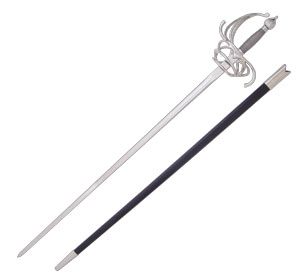Difference between revisions of "Steel rapier"
| Line 12: | Line 12: | ||
location=| | location=| | ||
rot=17| | rot=17| | ||
| + | userot=| | ||
repair=225 | repair=225 | ||
}} | }} | ||
| Line 18: | Line 19: | ||
{{Infobox:Holdable| | {{Infobox:Holdable| | ||
attack=30| | attack=30| | ||
| + | skillweight=80| | ||
defense=| | defense=| | ||
weight=50| | weight=50| | ||
| − | visible=yes | + | visible=yes| |
| + | rot=17| | ||
| + | userot=| | ||
| + | repair=225 | ||
}} | }} | ||
|} | |} | ||
Revision as of 21:00, 31 December 2006
| ||||||||||||||||||||
| ||||||||||||||||||||
Description and uses
Real-life context
"A rapier is a relatively slender (blade 2.5 centimetres or less in width), sharply pointed sword with a blade at least 90 centimetres in length, often sporting an elaborate hilt and hand-guard. For most of its period of use, the rapier was double-edged, some later rapiers were single-edged (with a sharply triangular blade) or edgeless. A rapier is capable of both cutting and thrusting attacks, but the thrust is the main attack in all rapier fighting styles." - Wikipedia - Rapier
"The rapier appeared in the early renaissance and was a civilian weapon. Contrary to popular belief, by modern standards it was a heavy and cumbersome sword, capable of attacks only and ill-suited to defense, a role usually relegated to the left hand or an auxiliary implement held in it. In time it evolved into the small-sword, a shorter and much faster weapon, one equally capable of attack and defense." - Sword Forum International
Images
